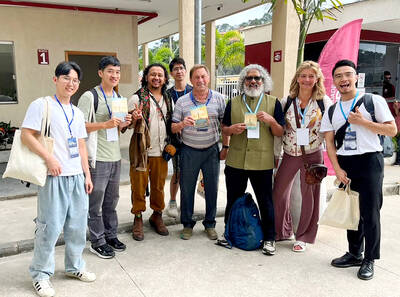When David Janes and Stomu Miyazaki launched a nonprofit a few years back aimed at teacher exchanges between the US and Asia, Taiwan wasn’t their first choice to inaugurate the program — it was Japan.
But Miyazaki, an architectural designer born in Japan, developed a special fondness for the island nation, where he had spent time designing a house in Kaohsiung.
“It felt like home,” he told the Taipei Times.

Photo: Chris Fuchs
That experience helped plant the seed to send a small cohort of American teachers to Taiwan this summer as part of a 10-day program conceived by EngageAsia, a US-based nonprofit.
The project aims to educate the teachers about Taiwan’s history, culture and society, while deepening their understanding of the Asia-Pacific region — all knowledge they will bring back to the classroom and share with their American students.
“When you’re thinking about northeast Asia, at least when I look at the field, there’s very few programs that take teachers to Taiwan,” Janes said. “And I think it’s something that a lot of teachers don’t think about at all.”
SOLD ON TAIWAN
Janes, whose day job is serving as director of foundation grants and assistant to the president of the United States-Japan Foundation, a nonprofit, said there are many programs that bring educators to China and Japan, and to a lesser extent Korea.
But after visiting Taiwan for the first time in October last year for a planning trip, he said he was sold on beginning the program there.
“Geographically, Taiwan is between Japan and China, but in a way it almost felt like culturally in-between,” Janes said.
Miyazaki, who taught interior design for eight years at an American university, said Taiwan could serve as an important hub when they expand their program to other Asian countries, including in Southeast Asia.
“This makes perfect sense rather than doing US-Japan,” Miyazaki said.
For their first Taiwan trip, Janes and Miyazaki said they wanted to start small with a handful of teachers from public schools in Westchester, New York. Following some seminars in the US, the group is expected to leave for Taiwan in late July, staying in Kaohsiung and Taipei.
Each teacher will pay US$2,000, a fee reduced from roughly US$6,000 as a result of fundraising and donations, including contributions from Janes and Miyazaki, the pair said. Janes said they had written two grant proposals to help fund the program but never heard back.
In Kaohsiung, the teachers will live with homestay families and have personal interpreters, according to Janes and Miyazaki. There they will research subjects they’ve chosen, among them culinary arts and people and daily life, and bring this material back to the American classroom.
The educators will also be armed with video cameras to record their activities, Miyazaki said.
INDEPENDENT EXPLORATION
Unlike some US-Asia programs where teachers stick together for much of the time, EngageAsia will aim to get them out on their own, Janes and Miyazaki said.
“We want to treat them like scholars instead of us sort of shepherding them around,” Janes explained.
That means pushing the educators out of their comfort zones, for instance getting them to secure their own meals, Miyazaki added, in a place where they don’t necessarily speak the language.
“It’s going to be a little bit tough … but that’s how you learn the different cultures,” he said. “To me, it’s the only way.”
After Kaohsiung, the group is slated to spend time in Taipei, participating in a design thinking workshop with high school teachers. Design thinking is a method of problem solving that seeks to identify alternative strategies and solutions that may not be immediately obvious.
Among other things, teachers during these workshop sessions will brainstorm ways to share what they learn with students back home in a manner that helps them feel and experience them, according to EngageAsia.
Janes added that an important component of the program is also to ensure teachers remain connected with the nonprofit.
“Wouldn’t it be great if we could get out of this sense of the only thing we’re trying to do is train American teachers to bring in content about Taiwan and somewhere else, [but] instead we’re also trying to have them foster ties with teachers from another country, real friendships that can grow?” he said.
This part will prove vital for EngageAsia in coming years, as a group of Taiwanese teachers is expected to travel to the United States in 2019 for a similar purpose.
ANGERING CHINA?
Janes and Miyazaki, neither of whom draws a salary from EngageAsia, noted that after Taiwan they plan to extend their nonprofit’s reach to Japan and Korea, as well as other Asian countries, which may include Singapore, Malaysia and Indonesia.
Both men did acknowledge the potential blowback that could arise from choosing Taiwan — viewed by China as a renegade province that must be reunited someday, by force if necessary — as its launching-off point for their program.
“I think it’s complicated, especially when you bring in China or Korea,” Janes said. “There are so many emotions over World War II ... there are territorial disputes, there are very different political structures.
“My hope is that we can make it clear to people that our goal is simply to provide teachers with an opportunity to learn about these other countries, to improve their own teaching, to improve opportunities for kids in their classroom to learn about these other countries.”

This month the government ordered a one-year block of Xiaohongshu (小紅書) or Rednote, a Chinese social media platform with more than 3 million users in Taiwan. The government pointed to widespread fraud activity on the platform, along with cybersecurity failures. Officials said that they had reached out to the company and asked it to change. However, they received no response. The pro-China parties, the Chinese Nationalist Party (KMT) and Taiwan People’s Party (TPP), immediately swung into action, denouncing the ban as an attack on free speech. This “free speech” claim was then echoed by the People’s Republic of China (PRC),

Exceptions to the rule are sometimes revealing. For a brief few years, there was an emerging ideological split between the Democratic Progressive Party (DPP) and Chinese Nationalist Party (KMT) that appeared to be pushing the DPP in a direction that would be considered more liberal, and the KMT more conservative. In the previous column, “The KMT-DPP’s bureaucrat-led developmental state” (Dec. 11, page 12), we examined how Taiwan’s democratic system developed, and how both the two main parties largely accepted a similar consensus on how Taiwan should be run domestically and did not split along the left-right lines more familiar in

Many people in Taiwan first learned about universal basic income (UBI) — the idea that the government should provide regular, no-strings-attached payments to each citizen — in 2019. While seeking the Democratic nomination for the 2020 US presidential election, Andrew Yang, a politician of Taiwanese descent, said that, if elected, he’d institute a UBI of US$1,000 per month to “get the economic boot off of people’s throats, allowing them to lift their heads up, breathe, and get excited for the future.” His campaign petered out, but the concept of UBI hasn’t gone away. Throughout the industrialized world, there are fears that

Most heroes are remembered for the battles they fought. Taiwan’s Black Bat Squadron is remembered for flying into Chinese airspace 838 times between 1953 and 1967, and for the 148 men whose sacrifice bought the intelligence that kept Taiwan secure. Two-thirds of the squadron died carrying out missions most people wouldn’t learn about for another 40 years. The squadron lost 15 aircraft and 148 crew members over those 14 years, making it the deadliest unit in Taiwan’s military history by casualty rate. They flew at night, often at low altitudes, straight into some of the most heavily defended airspace in Asia.